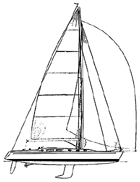Santana 20
One designr
One of the very first boats I reviewed was the Santana 20, designed by Shad Turner. Apparently it was a good review because Schock Corp. managed to sell 900 of these little boats. They were the very first of the "sport boats," i.e. high-performance, keel daysailers. The class grew to an active membership of 350 boats, many of them on inland lakes. Later the class began to dwindle and Tom Schock undertook a redesign of the venerable 20 with the help of the class president Jeff Kerr.
Today the class is healthy with 90 of the new boats added to the fleet and many of the older boats refitted with the newer deck. All efforts have been made to keep the older boats competitive. This year there will be 40 boats racing in the Denver area alone. The 20 is very popular with trailer sailors.
So what makes a successful one-design? You can draw and hype all you like and maybe you will even build a handful. But to establish a truly vital class, the first thing you need is a good boat, an exciting boat and a boat that attracts attention through its performance. An exception to this may be the J-Boats designs. But in that case the company has learned to build on the momentum of its first J/24.
The Santana 20 is a good boat, and owners and crews love it. The new model features a redesigned deck with a rolled cockpit edge like a 505 dinghy. This is very easy on the legs. The cockpit is now open to the transom making its working area at least seem bigger. The small, bullet-shaped cuddy cabin, which gives the 20 its very distinctive look, has been retained.
The appendages are the same with a 4-foot draft lead fin and a dated-looking low-aspect-ratio rudder. The hull itself is very shapely despite being drawn during the heyday of the IOR. Designer Turner avoided the "shapes du jour" of that period and created a smooth and fair bumpless hull for the 20. The stern is narrow compared to the wide dinghylike sterns of newer designs, and BWL is also broader giving the 20 good initial stability. (Most sailors love initial stability.) Overall, the hull shape is very moderate.
It's interesting to consider the possibility that the differences between this early sport boat and, say, a Melges 24, may be precisely the reason for the 20's longevity. This boat is very easy to sail and less physically demanding than the newer boats. This benign personality combined with its sparkling performance may be at the heart of its popularity. The boat is the perfect family day racer. Forget harnesses and dry suits, just go out and have fun.

Comments